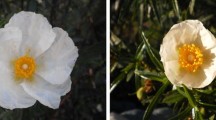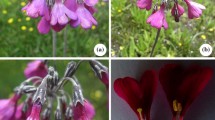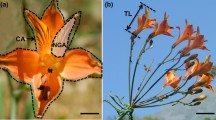Abstract
Animals which interact with plants often cause selective pressures on plant traits. Flower color variation within a species might be shaped by the action of animals feeding on the plant species. Pollinators might exert natural selection on color if flower color is related to their foraging efficiency. For example, some pollinator species might require more time to detect particular colors. If that is the case, flower color might have evolved as a pollination exploitation barrier—ensuring that flowers are more visited by the most efficient pollinators. In addition, non-pollinator agents such as predispersal seed predators may select on flower color, if color indicates food resources (seeds) or if color is related to deterrent compounds. We address selection on flower color in a population of Gentiana lutea where color varies among individuals from yellow to orange. We hypothesize that opposed selection from mutualists (pollinators) and antagonists (predispersal seed predators) maintains flower color variation in this population. By means of path analysis we addressed the role of both interactors in flower color selection. We found that selection acts on flower color, mediated by both pollinators and seed predators. Both agents favored yellow-flowered individuals, thus selection by pollinators and seed predators does not maintain flower color variation in this population.


Similar content being viewed by others
References
Arista M, Talavera M, Berjano R, Ortiz PL (2013) Abiotic factors may explain the geographical distribution of flower colour morphs and the maintenance of colour polymorphism in the scarlet pimpernel. J Ecol 101:1613–1622
Armbruster W (2002) Can indirect selection and genetic context contribute to trait diversification? a transition probability study of blossom colour evolution in two genera. J Evol Biol 15:468–486
Bradshaw H, Schemske DW (2003) Allele substitution at a flower colour locus produces a pollinator shift in monkeyflowers. Nature 426:176–178
Briscoe AD, Chittka L (2001) The evolution of color vision in insects. Annu Rev Entomol 46:471–510
Campbell DR (2009) Using phenotypic manipulations to study multivariate selection of floral trait associations. Ann Bot 103:1557–1566
Carlson JE, Holsinger KE (2013) Direct and indirect selection on floral pigmentation by pollinators and seed predators in a color polymorphic South African shrub. Oecologia 171:905–919
Caruso CM, Scott SL, Wray JC, Walsh CA (2010) Pollinators, herbivores, and the maintenance of flower color variation: a case study with Lobelia siphilitica. Int J Plant Sci 171(9):1020–1028
Chittka L, Waser NM (1997) Why red flowers are not invisible to bees. Isr J Plant Sci 45:169–183
CIE (2004) 15: 2004 Colorymetry. CIE Central Bureau, Vienna
Eckhart VM (1992) Spatio-temporal variation in abundance and variation in foraging behaviour of the pollinators of gynodioecious Phacelia linearis (Hydrophyllaceae). Oikos 64:573–586
Fenster CB, Armbruster WS, Wilson P, Dudash MR, James D (2004) Pollination syndromes and floral specialization. Annu Rev Ecol Evol Syst 35:375–403
Fineblum WL, Rausher MD (1997) Do floral pigmentation genes also influence resistance to enemies? The W locus in Ipomoea purpurea. Ecology 78(6):1646–1654
Frey FM (2004) Opposing natural selection from herbivores and pathogens may maintain floral-color variation in Claytonia virginica (Portulacaceae). Evolution 58(11):2426–2437
Gómez J (2000) Phenotypic selection and response to selection in Lobularia maritima: importance of direct and correlational components of natural selection. J Evol Biol 13:689–699
Grace JB (2006) Structural equation modeling and natural systems. Cambridge University Press, Cambridge
Green B, Durnford D (1996) The chlorophyll-carotenoid proteins of oxygenic photosynthesis. Annu Rev Plant Biol 47:685–714
Irwin RE, Strauss SY, Storz S, Emerson A, Guibert G (2003) The role of herbivores in the maintenance of a flower color polymorphism in wild radish. Ecology 84:1733–1743
Jones KM, Reithel JS (2001) Pollinator-mediated selection on a flower color polymorphism in experimental populations of Antirrhinum (Scrophulariaceae). Am J Bot 88:447–454
Kawecki TJ, Ebert D (2004) Conceptual issues in local adaptation. Ecol Lett 7(12):1225–1241
Kingsolver JG, Hoekstra HE, Hoekstra JM, Berrigan D, Vignieri SN, Hill CE, Hoang A, Gibert P, Beerli P (2001) The strength of phenotypic selection in natural populations. Am Nat 157(3):245–261
Kohlein F (1991) Gentians. Timber Press Inc, Portland
Kolb A, Ehrlén J, Eriksson O (2007) Ecological and evolutionary consequences of spatial and temporal variation in pre-dispersal seed predation. Perspect Plant Ecol Evol Syst 9(2):79–100
Kugler H (1943) Hummeln als Blütenbesucher. Ergebnisse der Biologie 19:323
Kunze J, Gumbert A (2001) The combined effect of color and odor on flower choice behavior of bumblebees in flower mimicry systems. Behav Ecol 12(4):447–456
Lande R, Arnold SJ (1983) The measurement of selection on correlated characters. Evolution 37:1210–1226
Lev-Yadun S, Gould KS (2009) Role of anthocyanins in plant defence. In: Gould K, Davies K, Winefield C (eds) Anthocyanins: biosynthesis, functions, and applications. Springer, New York, pp 21–48
Moehs CP, Tian L, Osteryoung KW, DellaPenna D (2001) Analysis of carotenoid biosynthetic gene expression during marigold petal development. Plant Mol Biol 45:281–293
Ninyerola M, Roure JM, Fernández XP (2005) Atlas climático digital de la Península Ibérica: metodología y aplicaciones en bioclimatología y geobotánica. Universidad Autónoma de Barcelona, Bellaterra
Peitsch D, Fietz A, Hertel H, de Souza J, Ventura DF, Menzel R (1992) The spectral input systems of hymenopteran insects and their receptor-based colour vision. J Comp Physiol A 170:23–40
Ploquin EF, Herrera JM, Obeso JR (2013) Bumblebee community homogenization after uphill shifts in montane areas of northern Spain. Oecologia 173:1649–1660
Price MV, Waser NM, Irwin RE, Campbell DR, Brody AK (2005) Temporal and spatial variation in pollination of a montane herb: a seven-year study. Ecology 86(8):2106–2116
Rausher MD (2008) Evolutionary transitions in floral color. Int J Plant Sci 169(1):7–21
Rodríguez-Gironés MA, Santamaría L (2004) Why are so many bird flowers red? PLoS Biol 2:e350
Rodríguez-Gironés MA, Santamaría L (2005) Resource partitioning among flower visitors and evolution of nectar concealment in multi-species communities. Proc Biol Sci 272:187–192
Rossi M (2011) Taxonomy, phylogeny and reproductive ecology of Gentiana lutea L. Dissertation. Universitá degli studi di Bologna, Bologna
Schemske DW, Bierzychudek P (2007) Spatial differentiation for flower color in the desert annual Linanthus parryae: was Wright right? Evolution 61:2528–2543
Spaethe J, Tautz J, Chittka L (2001) Visual constraints in foraging bumblebees: flower size and color affect search time and flight behavior. Proc Natl Acad Sci USA 98:3898–3903
StatSoft Inc. (2001) STATISTICA (data analysis software system), version 6. StatSoft Inc., Tulsa
Strauss SY, Irwin RE (2004) Ecological and evolutionary consequences of multispecies plant–animal interactions. Annu Rev Ecol Evol Syst 35:435–466
Strauss SY, Whittall JB (2006) Non-pollinator agents of selection on floral traits. In: Harder LD, Barret SCH (eds) Ecology and evolution of flowers. Oxford University Press, New York, pp 120–138
Strauss SY, Irwin RE, Lambrix VM (2004) Optimal defence theory and flower petal colour predict variation in the secondary chemistry of wild radish. J Ecol 92:132–141
Streisfeld MA, Kohn JR (2005) Contrasting patterns of floral and molecular variation across a cline in Mimulus aurantiacus. Evolution 59:2548–2559
Streisfeld MA, Kohn JR (2007) Environment and pollinator-mediated selection on parapatric floral races of Mimulus aurantiacus. J Evol Biol 20:122–132
Struwe L, Albert VA (2002) Gentianaceae: systematics and natural history. Cambridge University Press, Cambridge
Tanaka Y, Ohmiya A (2008) Seeing is believing: engineering anthocyanin and carotenoid biosynthetic pathways. Curr Opin Biotechnol 19:190–197
Tanaka Y, Sasaki N, Ohmiya A (2008) Biosynthesis of plant pigments: anthocyanins, betalains and carotenoids. Plant J 54:733–749
Veiga T, Galetto L, Machado I (2013) Nectar regulation in Euphorbia tithymaloides L., a hummingbird pollinated Euphorbiaceae. Plant Biol 15:910–918
Zhu C, Yamamura S, Koiwa H, Nishihara M, Sandmann G (2002) cDNA cloning and expression of carotenogenic genes during flower development in Gentiana lutea. Plant Mol Biol 48:277–285
Zhu C, Yamamura S, Nishihara M, Koiwa H, Sandmann G (2003) cDNAs for the synthesis of cyclic carotenoids in petals of Gentiana lutea and their regulation during flower development. Biochim Biophys Acta 1625:305–308
Zhu C, Bai C, Sanahuja G, Yuan D, Farré G, Naqvi S, Shi L, Capell T, Christou P (2010) The regulation of carotenoid pigmentation in flowers. Arch Biochem Biophys 504:132–141
Acknowledgments
The authors thank P. Domínguez for field assistance and E. Ploquin for bumblebees identification. Two anonymous reviewers and M. A. Rodríguez-Gironés made useful comments on a previous version of this manuscript. This work was financed by the Plan Nacional de I+D+I (2008–2011), CGL2009-08959 Ministerio de Ciencia. T.V. was supported by a PhD grant from the Plan Galego de Investigación e Crecemento 2011/2015 (Plan I2C), Consellería de Cultura, Educación e Ordenación Universitaria.
Author information
Authors and Affiliations
Corresponding author
Appendix
Appendix
UV light reflectance
UV light may influence pollinator choices but, if there are no differences on the UV light among orange and yellow flowering plants, we might conclude that pollinators may not distinguish the orange-flowered plants from the yellow-flowered plants due to UV light. So, we studied the UV reflectance variation among individuals associated to flower color in this species. We randomly selected 100 plants belonging to nine monomorphic populations (five orange and four yellow populations). Details of the procedure to obtain the spectra measures are identical to those described in “Materials and methods” section. We considered reflectance between 300 and 400 nm at each 10 nm intervals. Thus, UV color of each plant was described by 11 reflectance variables. We reduced those variables by means of a principal components analysis (PCA) to a single variable (which explained 75 % of the variance) describing UV reflectance. We run an analysis of variance with the first PCA component (UV reflectance) as the dependent variable. Color (orange or yellow) and population nested in color (since populations were monomorphic), were the independent variables.
None of those factors were statistically significant (F7,91 = 1.77, P = 0.10; F1,91 = 1.54, P = 0.22; respectively for population and color), which indicates that orange and yellow-flowered plants do not differ in the UV pattern of reflectance (Fig. 3) that there are not differences in the UV reflectance among populations.
Rights and permissions
About this article
Cite this article
Veiga, T., Guitián, J., Guitián, P. et al. Are pollinators and seed predators selective agents on flower color in Gentiana lutea?. Evol Ecol 29, 451–464 (2015). https://doi.org/10.1007/s10682-014-9751-6
Received:
Accepted:
Published:
Issue Date:
DOI: https://doi.org/10.1007/s10682-014-9751-6





